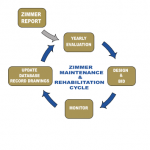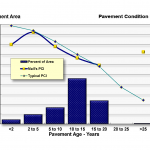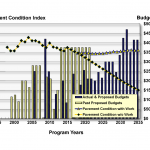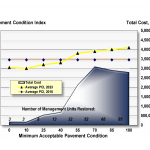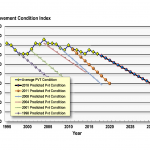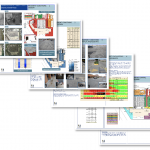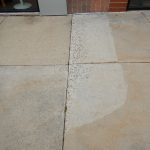Pavement Management Report Design: plans, specifications & estimates Bidding and review Construction observation Update pavement management database and record drawings Zimmer Consultants begins a new pavement maintenance & rehabilitation cycle with a pavement and site inspection followed by the Zimmer Report. The Report discusses condition and provides 10-year budgets. Once […]
The Zimmer Report: Pavement Performance
If you remember, an effective pavement management program requires three things, the size of the pavement area, the age of the pavement, and a repeatable, objective rating methodology which identifies pavement distress type, severity level, and amount of distress. With this information, we can plot the Figure above. It shows […]
The Zimmer Report: Budget & Condition
If the Zimmer report can be summarized in one Figure, it is what we call Budget & Condition. It presents four data sets plotted by year. The yellow line with solid, black diamonds is the actual, average pavement condition, PCI over time. For this example, after the 2018 data point […]
The Zimmer Report: Budget Consequence
There is a way to confidently answer your “What if” questions. What if we reduce the pavement rehabilitation budget? What is the effect on pavement conditions? Conversely, how much will it cost to improve the pavement condition by 10 points? Our Budget Consequence Figure presents a powerful tool to determine […]
The Zimmer Report: Pavement Condition History
By knowing the construction date or date of last overlay, we can make a prediction of future pavement conditions. This can be done for individual management units, a property, or for a portfolio. The Figure illustrates six pavement inspection points with predicted conditions at each point. The yellow diamonds present the […]
The Zimmer Report: Condition Frequency Charts
A property’s Pavement Condition Index (PCI) numbers can be divided into seven levels ranging from Excellent to Failed, and then charted. We call these figures condition frequency or FREQ charts. They are plotted two different ways, bars and stacked. They present the exact same data, but a user may find […]
Fun with Aerial Photographs
We research property history to determine the pavement age so, when used with the Pavement Condition Index, we can make predictions of future conditions. To do this we use aerial photographs starting with Google Earth Pro. Earth usually has photographs dating back to about 1990. Metropolitan areas may have older […]
The Zimmer Report: The Small Property Version
For over three decades, we have been refining the pavement management process for pavement owners. The Zimmer Report is the product of our ongoing processes to create useful documents for our clients. The image is of our short report for small properties. These reports will answer your questions about how […]
Is It Cement or Concrete? What is the Difference?
The terms ”concrete” and “cement” often seem interchangeable and when used to identify pavement type it can be confusing. There are both asphalt cement and asphalt concrete, and Portland cement and Portland cement concrete. Cement refers to the binding material used to “glue” the rock or aggregate together. The right […]
Frost Heave: Seriously, Fix the Problem
Frost heave is cause by a deep freeze of poorly drained, fine soils. The free moisture in the soil expands when frozen. The freezing draws more moisture up and into the frozen layer to create an ice lens. When the ice expands, the sidewalk is pushed up. The photograph shows […]
